
Viking Names
Snelland
The derivation of Snelland, in the Wraggoe Wapentake of Lincolnshire, is uncertain. The first element is either the Old Norse male personal name Snjallr or the Old English male personal name Snell, the second element is Old Norse lundr ‘a small wood’.
Read More

Viking Names
Brumby
The first element of the place-name Brumby, in the Manley Wapentake of Lincolnshire, is likely the Old Norse male personal name Brúni, although it has also been suggested it could be the Old Norse element brunnr ‘a well, spring’. The second element is bý ‘a farmstead, a village’.
Read More
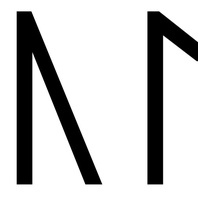
Viking Names
Tola
Tóla is a short form of names such as Þorlaug. It is an East Scandinavian name (Denmark, Sweden) and appears fairly frequently in Denmark. The name is also found in several Swedish runic inscriptions. It is attested in medieval documents from Lincolnshire referencing a woman who lived in Saltfleetby.
Read More
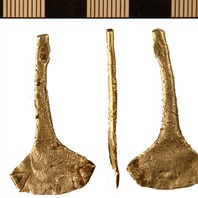
Viking Objects
Probable Thor’s Hammer Pendant (NLM-1A6811)
These may have been worn to show devotion to the god Thor, or to secure the god’s protection, although there is little evidence to support this interpretation. Pendants like this have been found made of lead, copper alloy, silver and gold, as well as other materials, showing that many different strata of society could have worn them. For more information on Scandinavian jewellery in England check out our blog: Brooches, Pendants and Pins: Scandinavian Dress Accessories in England.
Read More
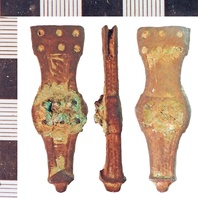
Viking Objects
Irish Strap-End (NLM-A30415)
This Irish-type strap-end has been classified as a Thomas Class F strap-end. One of the panels seems to have retained a possible reticulated interlace pattern while the inner area is decorated with six dots of inlay. Its manufacture is possibly traced to Dublin between c. 950-1050 and it is likely linked to Viking distribution of Irish artefacts. Strap-ends came in various styles and were fairly common throughout the Viking world. They were used to decorate the ends of belts and to stop them getting damaged.
Read More
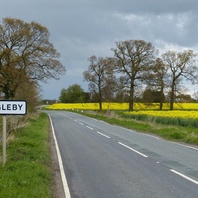
Viking Names
Ingleby
Ingleby, historically in the West Riding of Yorkshire, takes its name from the Old English ethnonym Engle ‘the Angles, later the English’ and Old Norse by ‘a farmstead, a village’. There is also an Ingleby in Derbyshire, close to the Viking winter camp at Repton, and the site of a unique Viking Age cremation cemetery. The exact implications of such a name are not yet fully understood and are the subject of ongoing work by Dr Jayne Carroll of the Institute for Name-Studies, University of Nottingham. Ingleby in Lincolnshire is now a joint parish with Saxilby.
Read More
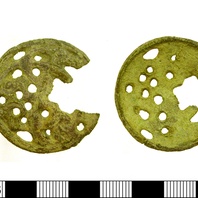
Viking Objects
Jellinge-Style Disc Brooch (LEIC-A30166)
This brooch has been classed under the Jansson Type I A1 category with decoration consisting of an openwork Jellinge design depicting an intertwined ribbon-like beast. For more information on Scandinavian jewellery in England check out our blog: Brooches, Pendants and Pins: Scandinavian Dress Accessories in England.
Read More
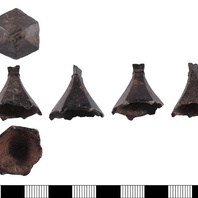
Viking Objects
Norse Bell (LIN-4509A8)
Bells of this type are described as a ‘Norse’ bell because of their association with Scandinavian sites though not much else is known about their purpose or origin. However, it seems likely that they were used as harness decorations.
Read More
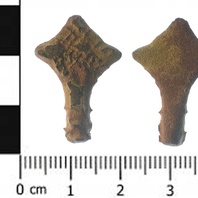
Viking Objects
Kite-Shaped Pin (SWYOR-53AEC4)
This type of kite-shape-headed pin is considered to be of Irish origin and imported through Viking activities.
Read More
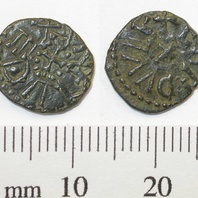
Viking Objects
Northumbrian Styca (DENO-87CE96)
This copper-alloy styca was minted by the moneyer Eardwulf in the name of King Ethelred II of Northumbria during his second reign. While Wessex and Mercia were using silver coinage as part of their monetary economy, Northumbria was using copper coins known as stycas, which may have contained trace amounts of silver. The concentration of these coins at sites such as Torksey and ARSNY suggests that they could have remained in circulation after the fall of Northumbria in 866 but were taken to the sites by the Vikings during their campaigning. they were not much use to the Vikings within their silver-based bullion economy but it is suggested that they were treated as raw material and were used as commodity money instead. The evidence for the production of copper-alloy strap-ends at Torksey and ARSNY supports this idea that the stycas were used for production.
Read More

Viking Objects
Samanid Silver Dirham (NCL-544D22)
A silver Samanid dirham of al-Shash dated possibly to 912 AD. The dirham was a unit of weight used across North Africa, the Middle East, and Persia, with varying values which also referred to the type of coins used in the Middle East during the Viking Age. These coins were extremely prized possessions not only for their silver value but as a way of displaying one’s wealth and vast trade connections. Millions of Arabic Dirhams would have been imported throughout the Viking world and are mostly found in hoards. Arabic dirhams demonstrate contact between the Viking diaspora and the Arabic world. Arabic coins are especially useful for dating sites, because they carry the date when they were minted. This permits precise dating where the part of the coin with the date survives, whereas European coins can only be dated to the reign of the ruler depicted on them. In western descriptions of these coins, the Arabic dates found on the coins are usually listed in square brackets, as above, and the European equivalent is listed after it.
